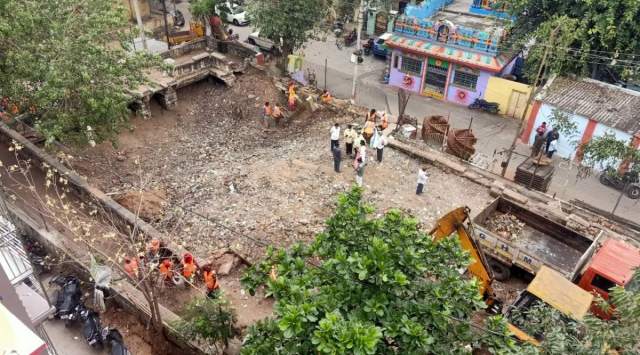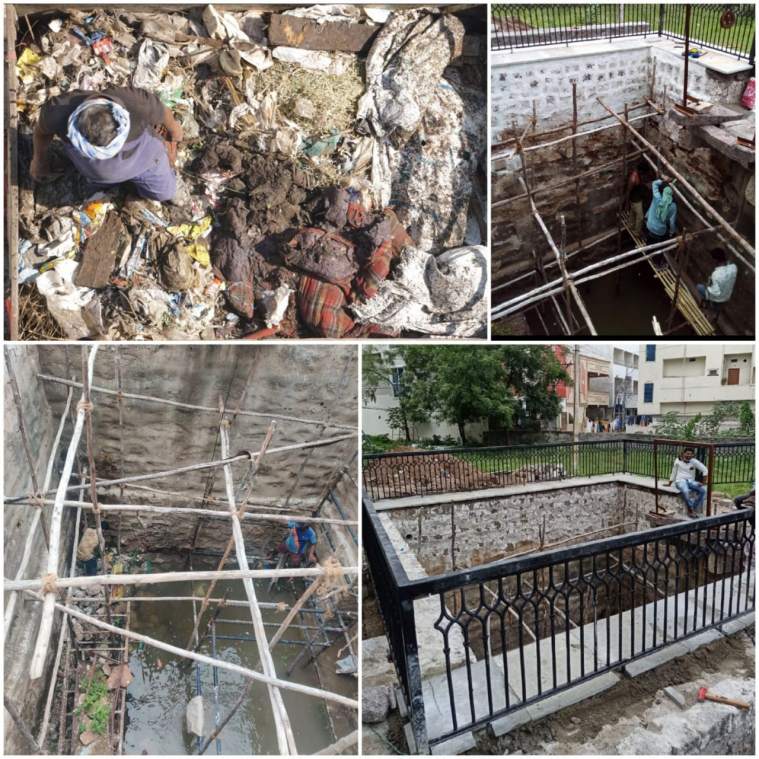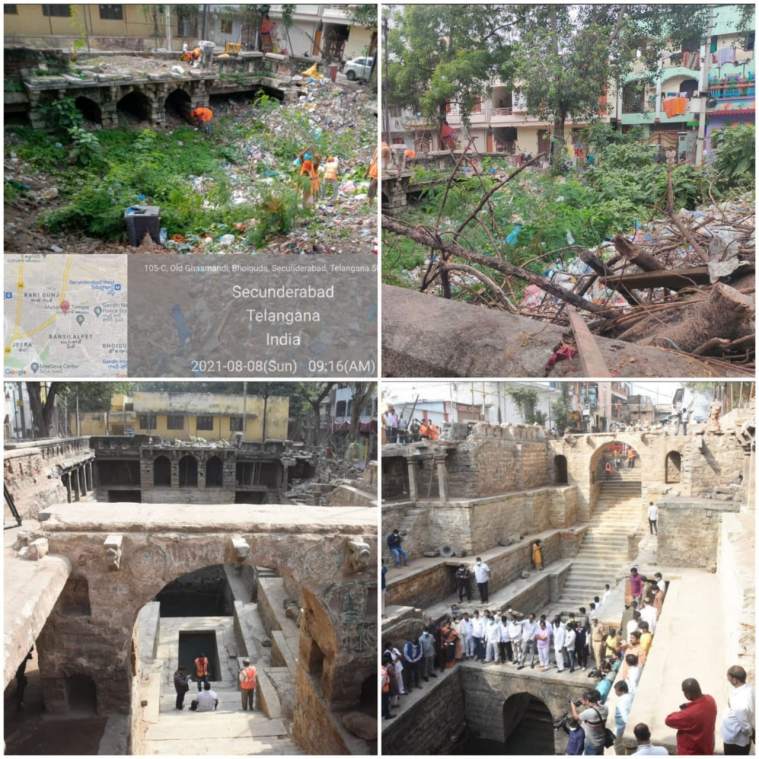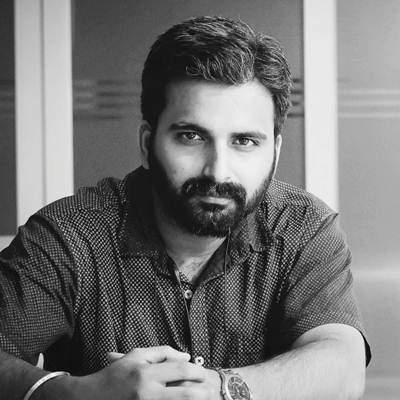Hyderabad: Start-up revives lost wells to help city’s sustainable development
Over the last two years, The Rainwater Project has revived at least six wells in and around Hyderabad with support from other NGOs, private donors, etc.
 The dumpyard in Bansilalpet in Secunderabad before the 17th-century stepwell was unearthed. (Photo: Special Arrangement)
The dumpyard in Bansilalpet in Secunderabad before the 17th-century stepwell was unearthed. (Photo: Special Arrangement)A heritage stepwell in Hyderabad has got a fresh lease of life. From removing 2,000 tonnes of debris dumped here for the last four decades, to relocating families that lived on the site, and studying archival material available about the site, a freshwater source was located at a depth of 20-25 feet and the overall water carrying capacity of the well thus rose to 22 lakh litres.
“Consider this. A garbage dump is now turned into a huge rainwater collection point. This will not only reduce the problem of urban flooding, but also improve groundwater quality, and create local water security by impacting at least 50 borewells,” said Kalpana Ramesh, founder of The Rainwater Project which undertook the well’s revival.
According to her, the 17th century well located in the busy localities of Secunderabad predates the model village called Bansilalpet that was established by the British. In a map dating back to 1834, the well is mentioned as Naganna’s well that must have existed in a tamarind and palmirah orchard. “Families were living near the site. They did not know that a well was present there. They thought the leftover dump area was to be converted into a parking space,” Kalpana added.
Unearthing a 22Lakh litres capacity landmark Heritage Stepwell has been an exciting journey. Three three major milestones acheived💧
Improving local water security, reducing urban floods and reducing ground water pollution.@KTRTRS @arvindkumar_ias @rainwater_info @SAHE_Hyd pic.twitter.com/ZHrYOCCvHF— kalpana ramesh (@kalpana_designs) January 23, 2022
Kalpana was one among the seven women from across the country to take over Prime Minister Narendra Modi’s social media accounts on women’s day in 2020. The Rainwater Project is her start-up that came into being at the International Institute of Information Technology (IIIT-Hyderabad). The start-up has developed a unique model where 70 per cent of its work, which revolves around providing innovative rainwater harvesting solutions for commercial projects for profit, will support and bootstrap 30 per cent of its public space projects. Over the last two years, it has revived at least six such wells in and around Hyderabad with support from other NGOs, private donors, etc.
The 200-year-old heritage well at Gachibowli, which was revived out of a garbage dump last year, has a water storage capacity of up to 8 lakh litres. Revival of an abandoned irrigation well at Kondapur has added rainwater harvesting potential of another 12 lakh litres. She believes scientific site-specific rainwater harvesting at individual plots and common spaces is as necessary as the revival of lakes. “Water is a public asset and rainwater is its cleanest source. A city cannot be sustainable if its urban development is not connected to water. Getting water from elsewhere is not a solution, considering the growing population,” she said.
 The 200-year-old heritage well at Gachibowli was revived last year.
The 200-year-old heritage well at Gachibowli was revived last year.
An interior architect and designer by profession, Kalpana’s tryst with rainwater harvesting efforts began several years ago when the sight of water tankers and dependency on them for months started to bother her. She took up various initiatives to save lakes and revive dead borewells, besides creating awareness on rainwater harvesting at gated communities. Her start-up has studied the rainwater potential of the city by dividing it into 98 micro watershed blocks to offer site-specific harvesting solutions.
“As a case, we studied the Madhapur area. By connecting rooftops to rainwater harvesting pits, we understood that such a large area can survive for a year without any water tankers. Site-specific and data-driven understanding of water potential is required. Pushing for zero discharge, we say that 85 per cent of water from a household can be recycled,” she said. But it was while volunteering with Hyderabad Design Forum, a group of 12 architects led by Yeshwant Ramamurthy, that she started locating and documenting the lost stepwells of Telangana.
Gachibowli well is being restored & recharge springs have come alive. There’s also a sitting area being created around
Well done@rainwater_info@kalpana_designs
& thanks @ChirecSchool for funding the restorationCommunity participation can do wonders @KTRTRS pic.twitter.com/EtNGgayLHX
— Arvind Kumar (@arvindkumar_ias) July 19, 2021
Learning about traditional water systems, understanding the engineering behind it, location of water collection, and distribution points — the group has found and documented more than 200 heritage wells across Telangana in the last four years. “Along with the revival of wells, connecting water stories to urban stories, too, is important. These wells were public spaces of cultural importance. Restoring the structure and ensuring the quality of catchment, too, is important for its survival,” she noted.
A heritage well at Baram Baavi in Narayanpet district was revived and restored to its original form by The Rainwater Project in October last year. The social enterprise has also taken up efforts to make government schools zero-discharge points and is currently working with two such schools to set up modular rainwater harvesting systems.
Incredible India, showcasing Incredible Heritage,Culture and Water Wisdom 🙏🏻🌺#BaramBaaviRestoration @harichandanaias for your incredible support . Hope to see more wells restored in the coming years💧 @KTRTRS @arvindkumar_ias @JalShaktiAbhyan @rainwater_info @SatyaDulam pic.twitter.com/LE2zHOKJ7v
— kalpana ramesh (@kalpana_designs) October 13, 2021
Around Rs 34 lakh has been spent to date on the revival of the heritage well at Bansilalpet. Phase 2 of the project, which comprises condition mapping and conservation plan for the structure and its restoration, is expected to cost another Rs 70-80 lakh. “Going ahead with the same model of funding our projects, crowdfunding as well as support from donors, we aim to do another 20 wells in the next 2 years. These wells are huge rainwater collection points that are important for the sustainability of a city,” she explained.
 Around Rs 34 lakh has been spent to date on the revival of the heritage well at Bansilalpet
Around Rs 34 lakh has been spent to date on the revival of the heritage well at Bansilalpet













